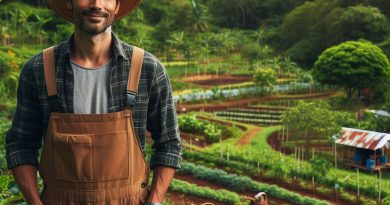IPM: Balancing Nature & Agriculture Sustainably
Last Updated on January 21, 2024
Introduction
IPM: Integrated Pest Management is a comprehensive approach to pest management.
Balancing nature and agriculture sustainably is crucial for the environment and food production.
IPM goes beyond conventional pest control, embracing a holistic philosophy that transcends the mere suppression of pests.
It encapsulates a dynamic synergy between natural predators, resilient crops, and judicious pesticide use.
Rooted in ecological principles, IPM emphasizes proactive measures such as crop rotation, habitat diversification, and biological controls to minimize the reliance on chemical interventions.
This nuanced approach not only mitigates the environmental impact but also cultivates agro-ecosystems that are inherently resistant to pest pressures.
By fostering a biodiverse environment, IPM cultivates a living shield, where beneficial organisms act as allies in the quest for sustainable agriculture.
Farmers adopting IPM methods become stewards of the land, navigating the intricate interplay between pest dynamics and natural checks and balances.
Moreover, IPM acknowledges the interconnectedness of ecosystems, recognizing that the health of soil, water, and air are integral to agricultural success.
As a result, it promotes practices that enhance soil fertility, reduce water usage, and limit air pollution, creating a harmonious cycle that reciprocally benefits both the land and its caretakers.
In essence, Integrated Pest Management represents a paradigm shift in agriculture, advocating for a future where productivity and ecological health coalesce.
Through this exploration, we invite you to join the journey of balancing nature and agriculture sustainably, delving into the realms of innovation, conservation, and resilience that define the tapestry of IPM.
What is IPM?
Definition and explanation of IPM
Integrated Pest Management (IPM) is a sustainable approach that combines various methods to manage pests effectively while minimizing ecological, economic, and health risks.
Unlike conventional chemical-intensive practices, IPM focuses on long-term pest prevention and employs a holistic approach to maintaining the balance between nature and agriculture.
Key principles and strategies of IPM
Pest monitoring and identification
IPM emphasizes the importance of continuously monitoring pest populations and accurately identifying the pests present in an agricultural setting.
This allows farmers to determine the appropriate actions to take, based on knowledge about the pest’s biology, behavior, and lifecycle.
Preventive measures
One of the fundamental principles of IPM is to emphasize preventive measures to control pests.
These measures include implementing proper farm hygiene practices, crop rotation, planting pest-resistant crop varieties, and optimizing growing conditions to promote plant health and resilience.
Biological control
IPM encourages the use of natural enemies, such as predators, parasitoids, and pathogens, to control pest populations.
Biological control methods include introducing these beneficial organisms into the ecosystem, conserving their habitats, and implementing techniques that enhance their effectiveness in suppressing pests.
Chemical control as a last resort
While chemical control methods are often necessary when pest populations reach alarming levels, IPM promotes the judicious and minimal use of pesticides.
It encourages farmers to choose pesticides that have lower environmental impact, target specific pests, and use them only when all other methods have failed or are not economically viable.
By following these key principles and strategies, IPM aims to achieve sustainable pest management that protects both the environment and human health.
It recognizes the interconnectedness of nature and agriculture, respecting the delicate balance necessary for productive and resilient farming systems.
IPM is a dynamic and adaptive approach, constantly evolving with new scientific research and innovative practices.
It requires continuous learning, knowledge-sharing, and collaboration among farmers, researchers, extension workers, and policymakers to successfully implement and refine IPM strategies.
The benefits of IPM go beyond just pest control. It reduces reliance on harmful pesticides, lowers production costs, increases crop yields, improves food safety, and preserves biodiversity by minimizing the impact on non-target organisms.
Additionally, IPM contributes to the long-term sustainability of agricultural systems by minimizing the development of pest resistance and reducing environmental pollution.
In fact, IPM is a strategic and eco-friendly approach to pest management.
By integrating various techniques and emphasizing prevention, monitoring, and the use of biological controls, IPM helps farmers achieve a balanced coexistence between nature and agriculture.
Its principles and strategies empower farmers to make informed decisions, conserve resources, and ensure the sustainability of our food production systems.
Read: Eco-Friendly IPM Techniques in Modern Farms
Benefits of Implementing IPM
When it comes to pest management in agriculture, Integrated Pest Management (IPM) has proven to be a sustainable approach that balances the needs of agriculture with the preservation of the natural environment.
By utilizing a combination of preventive measures, monitoring, and targeted interventions, IPM reduces reliance on pesticides while still effectively managing pests.
This approach offers several significant benefits that make it a preferred choice for farmers and the overall ecosystem.
Reduced reliance on pesticides
One of the key advantages of implementing IPM is the reduced reliance on pesticides.
Traditional pest control practices often involve the routine and indiscriminate use of pesticides, which can have detrimental effects on the environment, including the killing of beneficial organisms.
IPM, on the other hand, emphasizes the use of non-chemical control methods as the first line of defense against pests.
This approach not only minimizes the negative environmental impact but also reduces the risk of developing pesticide resistance.
Preservation of beneficial organisms
Preserving beneficial organisms is another important benefit of IPM.
Many insects, birds, and other organisms play a vital role in pollination, natural pest control, and overall ecosystem health.
By promoting diverse habitats and implementing targeted pest control methods, IPM helps maintain populations of these beneficial organisms.
This, in turn, contributes to the overall biodiversity and resilience of the agricultural system.
Improved sustainability and long-term profits for farmers
Moreover, IPM practices lead to improved sustainability and long-term profits for farmers.
By reducing the use of pesticides, farmers can save on input costs and increase their profit margins.
Additionally, IPM focuses on long-term pest management solutions, which can lead to healthier and more productive crops.
This helps ensure the sustainability of agricultural practices and enables farmers to secure their livelihoods in the face of evolving pest pressures.
Minimal impact on the environment
Implementing IPM also has minimal impact on the environment.
By utilizing a combination of cultural, biological, and physical control methods, IPM reduces the amount of chemicals released into the environment.
This approach helps protect soil quality, water sources, and air quality, leading to healthier ecosystems both on and off the farm.
Better human health and safety
Lastly, IPM prioritizes human health and safety. Traditional pest control methods often expose farmers, farm workers, and consumers to harmful chemicals.
IPM, on the other hand, aims to minimize these risks by using less-toxic pest control approaches.
By reducing pesticide exposure, IPM promotes better human health and safety for those working in agriculture and consuming the produce.
In short, implementing IPM practices offers numerous benefits for agriculture and the environment.
From reducing reliance on pesticides and preserving beneficial organisms to improving sustainability and long-term profits for farmers, IPM ensures a balanced approach to pest management.
By minimizing environmental impact and promoting human health and safety, IPM serves as a sustainable solution for agriculture, allowing us to achieve a harmonious coexistence between nature and agriculture.
Read: Soil Conservation: Tackling Erosion Smartly
Successful Case Studies
IPM application in organic farming
Organic farming is gaining popularity worldwide due to its focus on sustainable and environmentally friendly practices.
Integrated Pest Management (IPM) plays a crucial role in ensuring the success of organic farming by balancing nature and agriculture sustainably.
Let’s explore some successful case studies where IPM has been effectively applied in organic farming.
Use of trap crops and beneficial insects
One remarkable example of IPM application in organic farming is the use of trap crops and beneficial insects.
Farmers strategically plant specific crops that attract pests, diverting them away from the main crop.
Beneficial insects like ladybugs and praying mantises are also introduced to control the pest population naturally.
This method reduces the reliance on chemical pesticides, promoting a healthier ecosystem.
Monitoring and early pest detection
Monitoring and early pest detection are essential aspects of IPM in organic farming. Farmers regularly inspect their crops, looking for signs of pests or diseases.
By identifying the problem early, they can take appropriate measures to control the infestation without resorting to harsh chemicals.
This proactive approach minimizes crop damage and ensures a high-quality yield.
Reduced need for synthetic inputs
One of the significant benefits of IPM in organic farming is the reduced need for synthetic inputs.
Instead of relying solely on chemical pesticides and fertilizers, farmers adopt a holistic approach that focuses on natural solutions.
They use biological controls, such as pheromone traps and insect-repelling plants, to manage pests effectively.
This not only protects the environment but also preserves the health of farm workers and consumers.
IPM adoption in large-scale commercial agriculture
IPM is not limited to organic farming but can also be successfully adopted in large-scale commercial agriculture.
Here are some examples of how IPM has been implemented in such settings.
Crop rotation and diversification
Crop rotation and diversification are key practices in IPM for large-scale commercial agriculture.
Planting different crops in a specific sequence helps to break the life cycle of pests and diseases.
It also improves soil health, reduces nutrient depletion, and enhances overall crop productivity.
By rotating crops, farmers can naturally suppress pest populations, resulting in reduced pesticide usage.
Integration of biopesticides and biocontrols
The integration of biopesticides and biocontrols is another effective IPM technique used in commercial agriculture.
Biopesticides are derived from naturally occurring substances, such as certain bacteria or fungi, and they target specific pests without harming beneficial insects or pollinators.
Farmers also introduce biocontrols like predatory insects or nematodes to keep pest populations in check.
This approach ensures effective pest management while minimizing environmental impact.
Maintaining ecological balance
Successful IPM adoption in large-scale commercial agriculture requires maintaining ecological balance.
Farmers strive to create biodiverse habitats on their farms, preserving natural areas and planting wildflowers to attract pollinators.
They also utilize techniques like cover cropping and conservation tillage to minimize soil erosion and improve water quality.
By considering the overall ecosystem, IPM ensures the sustainability of both agriculture and the environment.
In general, these case studies demonstrate the effectiveness of IPM in balancing nature and agriculture sustainably.
Whether in organic farming or large-scale commercial agriculture, IPM offers practical solutions that reduce reliance on synthetic inputs while effectively managing pests and diseases.
By adopting IPM practices, farmers can achieve long-term success while protecting the environment and ensuring safe and healthy food production.
Read: Permaculture Principles: Soil Health Focus

The Role of Technology in IPM
In Integrated Pest Management (IPM), technology plays a crucial role in achieving sustainable balance between nature and agriculture.
Technological advancements have opened doors to innovative and efficient methods of pest control while minimizing the negative impact on the environment.
Utilizing precision agriculture techniques
Utilizing precision agriculture techniques is a key aspect of implementing IPM.
Crop sensors and remote sensing
Crop sensors and remote sensing allow farmers to gather detailed information about their crops and detect potential pest infestations early on.
By monitoring crop health and quickly identifying areas of concern, farmers can take targeted actions to address pest issues without resorting to widespread pesticide use.
Weather forecasting and predictive models
Weather forecasting and predictive models further aid in decision-making by providing insights into favorable conditions for pest development, enabling farmers to proactively protect their crops.
Digital tools for pest monitoring and data analysis
Smartphone apps for pest identification
Digital tools have revolutionized pest monitoring and data analysis, making it easier than ever to track and analyze pest populations.
Smartphone apps have been developed to aid farmers in identifying pests accurately.
These apps use image recognition technology, allowing users to upload pictures of pests and receive real-time information on species, behavior, and control methods.
This tool simplifies the process of pest identification, empowering farmers to make informed decisions regarding pest management.
Real-time data collection and analysis
Real-time data collection and analysis have greatly improved IPM strategies.
With the help of digital tools and sensor technologies, farmers can gather data on pest populations, crop growth, and environmental factors.
This data is then analyzed to identify patterns and trends, enabling farmers to make data-driven decisions about pest control interventions.
Real-time data analysis allows for timely and targeted responses, minimizing the use of pesticides and optimizing the effectiveness of pest management measures.
Advances in biological control methods and genetic engineering
Development of pest-resistant crops
Advances in biological control methods and genetic engineering have also contributed to sustainable pest management in agriculture.
Scientists are continuously developing pest-resistant crops through genetic modification.
These crops possess genes that make them less susceptible to pests and diseases, reducing the need for chemical insecticides.
Biotechnology for targeted pest control
Biotechnology, such as gene editing, offers precise and targeted pest control methods that minimize collateral damage to beneficial organisms and the environment.
By harnessing the power of biological control and genetic engineering, IPM can achieve long-term sustainability in agriculture.
In brief, technology plays a vital role in implementing IPM by providing innovative tools and techniques for pest control and data analysis.
Precision agriculture techniques, digital pest monitoring tools, and advances in biological control methods and genetic engineering contribute to the sustainable and environmentally friendly management of pests.
By embracing these technological advancements, farmers can strike a delicate balance between nature and agriculture, ensuring the long-term viability of our food production systems.
Read: Cover Crop Mixes: Soil Health Multipliers
Challenges and Future Directions
Economic constraints for small-scale farmers
Small-scale farmers often struggle with economic constraints, hindering their ability to adopt and implement IPM practices.
Limited resources and financial challenges make it difficult for them to invest in necessary tools, training, and infrastructure.
This issue needs to be addressed by providing financial and technical support to small-scale farmers, ensuring they can access the resources required for effective IPM implementation.
Knowledge and awareness gaps among farmers
In addition to economic constraints, knowledge and awareness gaps among farmers pose a significant challenge to promoting sustainable IPM practices.
Many farmers may not have access to proper education and training regarding IPM techniques.
It is essential to invest in farmer education programs that provide information and training on the benefits and methods of IPM.
Raising awareness about IPM can help overcome barriers and encourage farmers to adopt sustainable pest management practices.
Policy and regulatory support for IPM
To create an enabling environment for IPM, policy and regulatory support is critical.
Governments and regulatory bodies should develop and implement policies that promote, incentivize, and regulate the use of IPM practices.
The implementation of supportive policies can help overcome barriers such as the excessive use of chemical pesticides and promote the adoption of sustainable pest management practices.
Research and development advancements in IPM
Research and development advancements play a crucial role in improving and advancing IPM strategies.
Continuous research is necessary to identify new pest control methods, monitor pest behavior, and develop innovative technologies.
Research and development efforts should focus on finding environmentally friendly and economically viable alternatives to conventional pesticides.
This will help farmers reduce their reliance on harmful chemicals and adopt safer and more sustainable pest management practices.
Collaborative efforts between farmers, researchers, and policymakers
Collaboration among farmers, researchers, and policymakers is vital to drive the widespread adoption of IPM.
Farmers’ practical knowledge and experiences can contribute to research and development efforts.
Researchers can provide scientific expertise and innovative solutions, while policymakers can implement supportive policies based on evidence-based research.
Engaging all stakeholders in dialogues, collaborations, and knowledge-sharing platforms can lead to effective pest management strategies that are both ecologically sustainable and economically viable.
In a nutshell, while IPM offers a sustainable approach to pest management, challenges remain.
Economic constraints for small-scale farmers, knowledge and awareness gaps, policy and regulatory support, research and development advancements, and collaborative efforts are crucial areas that need attention.
Overcoming these challenges and working towards a balanced approach between nature and agriculture will contribute to a more sustainable and environmentally friendly food production system.
Conclusion
Integrated Pest Management (IPM) plays a crucial role in maintaining a sustainable balance between nature and agriculture.
By utilizing various strategies such as biological control, crop rotation, and habitat preservation, IPM minimizes the use of chemical pesticides and promotes the health of ecosystems.
It is essential for farmers to embrace IPM practices to ensure long-term viability and profitability of their farms.
By implementing IPM, farmers can reduce pesticide usage, protect beneficial insects, and increase crop productivity while minimizing negative impacts on the environment and human health.
Given the importance of IPM in sustainable agriculture, it is imperative to continue investing in research and development of innovative IPM technologies.
Additionally, promoting education and awareness about IPM among farmers, agricultural professionals, and policymakers is crucial for its widespread adoption and long-term success.
By collectively strengthening IPM practices and knowledge, we can ensure a sustainable future for agriculture while preserving the delicate balance of nature.


